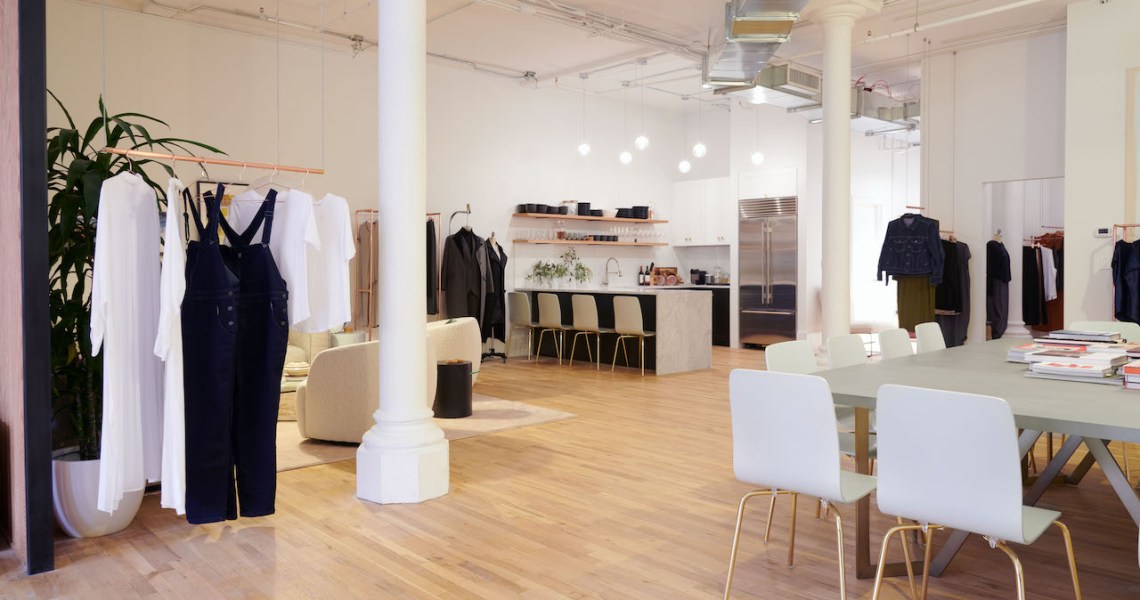On Tuesday, Universal Standard opened its latest experiential space in New York City. It’s a place where customers can work with a brand stylist and buy some of the latest products, but it also doubles as a kind of clubhouse that any shopper can rent for an evening. For no additional cost, consumers can host a private dinner party or a book club meeting. It’s all in the vein of Universal Standard’s new push to acquire customers at a lower cost and subsequently, drive sales.
With increasing customer acquisition costs on Instagram and Facebook, many direct-to-consumer brands are looking to diversify their marketing mixes via physical retail, direct mail and outdoor ads. Additionally, fashion companies from Lively to Ganni have put less product and allowed for more physical space in retail stores to create an environment where customers want to spend more time in. Over the last five months, Universal Standard has taken a similar approach, opening retail concepts that are less product-focused and more experience-driven.
In a five-month period, Universal Standard will have launched five of these concepts, with the fifth opening at the end of the week in Portland, Oregon. Other locations include Houston, Seattle and Chicago. Going into 2020, the company hopes to open another five of these “clubhouses,” the brand’s cofounders, Polina Veksler and Alexandra Waldman, said. Cities that are selected tend to be markets with an existing community of engaged customers, and when the brand opens a clubhouse online sales in those cities rise.
Each space serves two purposes. It gives customers a showroom experience where they can shop the latest collection through a personal styling appointment. Customers can either drop-in or book an appointment online.
Items in the space are available for purchase, but the brand doesn’t plan to carry too much inventory inside these locations. The strategy is to keep operational costs low for the clubhouse, but drive sales up in stores and online.
“Our repeat purchase rate goes up, days between purchases go up and average order value goes up. Doing it this way allows us to give back to the community, but not having a lot of [stock] allows us to save money,” said Polina Veksler, cofounder of Universal Standard.
A spokesperson for Universal Standard said that in the other three locations that have already opened, the company has seen,”an immediate and sustained increase in online sales,” across the board, but declined to share specifics.
While the styling service is one way to grow a customer base, the second purpose of these spaces is to acquire new customers. To do that, the brand lets any customer book the entire space at no cost or any kind of membership fee. Shoppers do have to pay for catering, but Universal Standard provides a cozy spot complete with a fully equipped kitchen, a dining table, couches and bathrooms. In the three existing locations, Universal Standard hosts about two to five private events a week.
For Universal Standard, this strategy is not so much about slashing the company’s digital marketing budget or scaling back on Instagram ads. But more, keeping those CAC across Facebook and Instagram at a constant as Universal Standard continues to grow. In Feb. 2018, Universal Standard closed a $7 million round of Series A funding led by Imaginary Ventures; in total, the company has raised $8.5 million in funding.
“You can’t be a DTC brand without digital marketing, it just doesn’t work, but I do believe you have to diversify your funnel. We don’t currently spend that much on Facebook and Instagram, so we are still at the scale of spend where we have not seen any increases, but I think as we continue to grow and our spending continues to increase, it is inevitable,” said Veksler.
Universal Standard is seeing success so far with these flexible store concepts, but Anthony Coppers, head of innovation at creative agency Gradient, said the true benefits of these types of experiences come from how any collected customer data points is used down the line.
“Experience is all about how much data mining you do,” Coppers said. “How you take that information, what you do with it and what kind of innovative technologies you use to communicate with the people you met in the offline world to later connect in the online world.”




